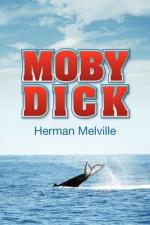Next was Tashtego, an unmixed Indian from Gay Head, the most westerly promontory of Martha’s Vineyard, where there still exists the last remnant of a village of red men, which has long supplied the neighboring island of Nantucket with many of her most daring harpooneers. In the fishery, they usually go by the generic name of Gay-Headers. Tashtego’s long, lean, sable hair, his high cheek bones, and black rounding eyes—for an Indian, Oriental in their largeness, but Antarctic in their glittering expression—all this sufficiently proclaimed him an inheritor of the unvitiated blood of those proud warrior hunters, who, in quest of the great New England moose, had scoured, bow in hand, the aboriginal forests of the main. But no longer snuffing in the trail of the wild beasts of the woodland, Tashtego now hunted in the wake of the great whales of the sea; the unerring harpoon of the son fitly replacing the infallible arrow of the sires. To look at the tawny brawn of his lithe snaky limbs, you would almost have credited the superstitions of some of the earlier Puritans and half-believed this wild Indian to be a son of the Prince of the Powers of the Air. Tashtego was Stubb the second mate’s squire.
Third among the harpooneers was Daggoo, a gigantic, coal-black negro-savage, with a lion-like tread—an Ahasuerus to behold. Suspended from his ears were two golden hoops, so large that the sailors called them ringbolts, and would talk of securing the top-sail halyards to them. In his youth Daggoo had voluntarily shipped on board of a whaler, lying in a lonely bay on his native coast. And never having been anywhere in the world but in Africa, Nantucket, and the pagan harbors most frequented by the whalemen; and having now led for many years the bold life of the fishery in the ships of owners uncommonly heedful of what manner of men they shipped; Daggoo retained all his barbaric virtues, and erect as a giraffe, moved about the decks in all the pomp of six feet five in his socks. There was a corporeal humility in looking up at him; and a white man standing before him seemed a white flag come to beg truce of a fortress. Curious to tell, this imperial negro, Ahasuerus Daggoo, was the Squire of little Flask, who looked like a chess-man beside him. As for the residue of the Pequod’s company, be it said, that at the present day not one in two of the many thousand men before the mast employed in the American whale fishery, are Americans born, though pretty nearly all the officers are. Herein it is the same with the American whale fishery as with the American army and military and merchant navies, and the engineering forces employed in the construction of the American Canals and Railroads. The same, I say, because in all these cases the native American literally provides the brains, the rest of the world as generously supplying the muscles. No small number of these whaling seamen belong to the Azores, where the outward bound Nantucket whalers frequently




